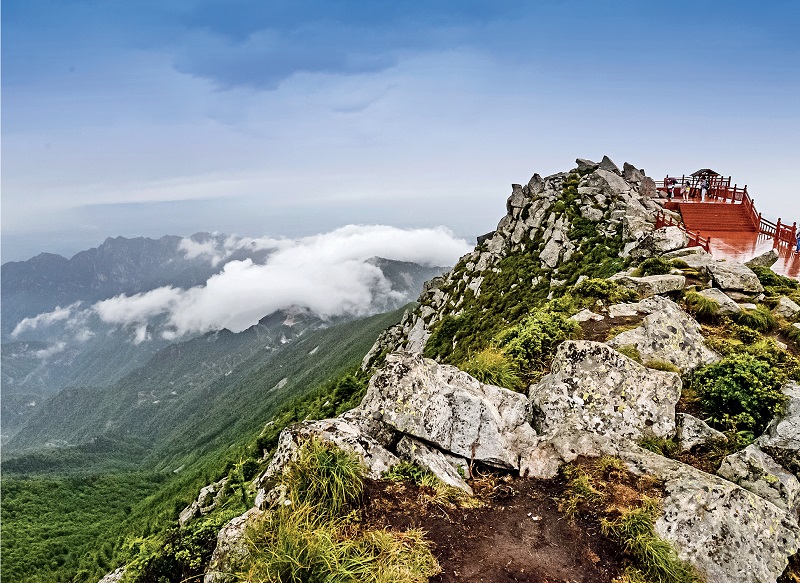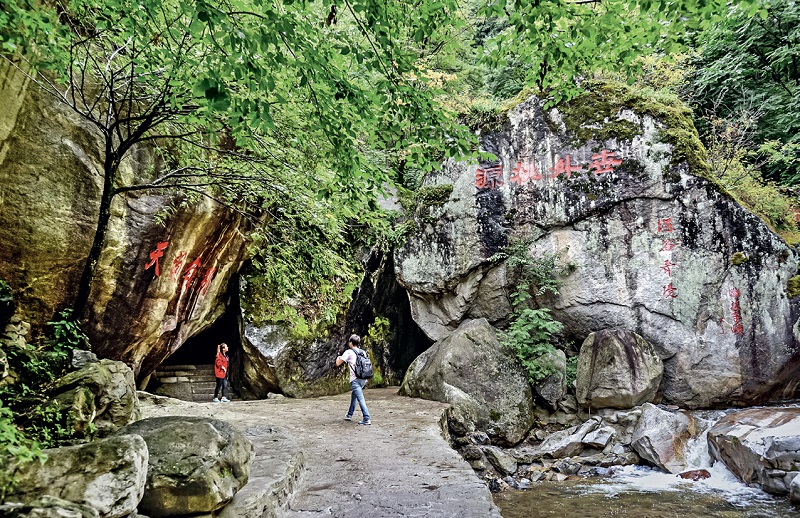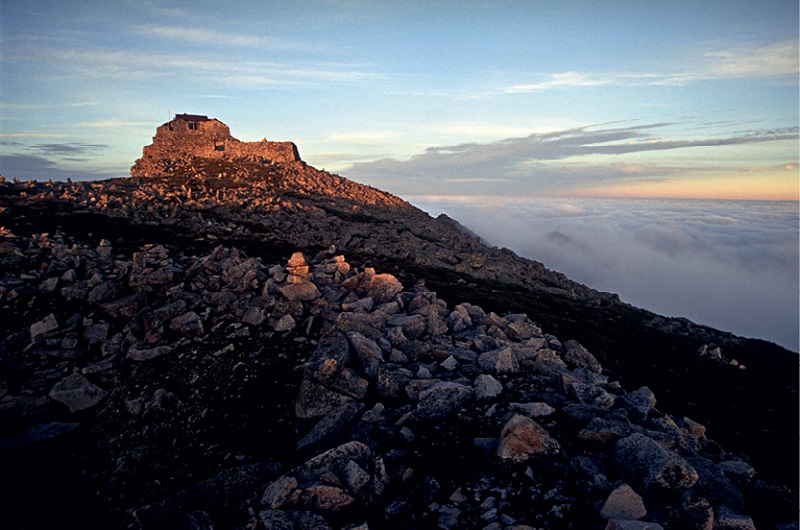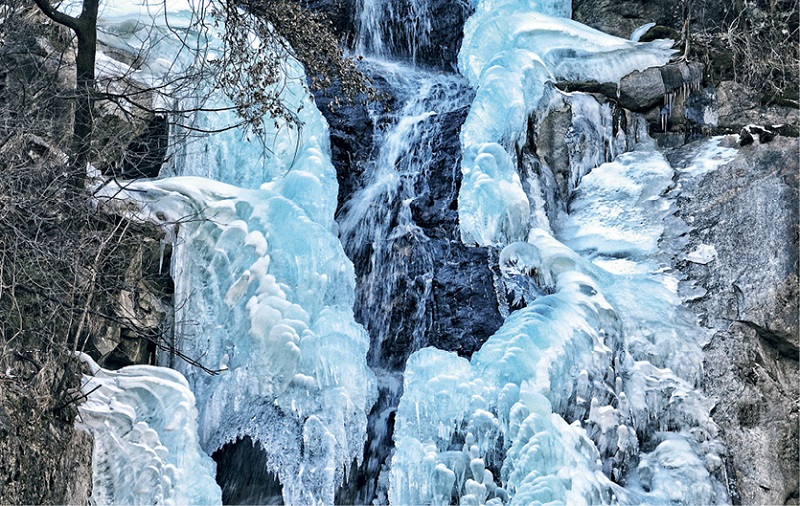The Immortal Taibai Mountain

A view point of the Taibai Mountain is set at an altitude of 3,511 meters above sea level.
The Taibai Mountain in Baoji, Shaanxi Province, is a range of major mountain peaks in the famous Qinling Mountains in China, having the highest peak east of the Qinghai-Tibet Plateau. Rising from the plains, its elevation ranges more than 3,000 meters with the highest peak reaching 3,771.2 meters. Today, the Taibai Mountain is a national forest park and ranked a national 5A tourist attraction. The park covers an area of 2,949 hectares and has more than 180 tourist attractions in eight major scenic areas.
The Taibai Mountain is located in the middle section of the Qinling Mountains, which form an important geographical dividing line between southern and northern China, as well as the watershed of two major water systems, the Yangtze River and the Yellow River, with a warm temperate zone in the north and a subtropical zone in the south. The Taibai Mountain National Forest Park now is a haven to 15 nationally protected plant species and nearly 30 species of endemic plants, hence a world-famous natural gene pool in biodiversity. The mountain area is also a transitional zone where the three regions of North China, Central China and Qinghai-Tibet Plateau meet.

Hikers meandering through a maze of giant rocks and a sea of trees.
The Divine Path
As tourists enter the park, they may feel like they are walking into the arms of green trees and can feel the breeze and smell leaves with mud scent. The foot of the mountain is covered in greenery while the summit is so cold that it is covered with snow all year round, thus winning the name Taibai, which means extremely white.
The hiking trail from the Xiaban Temple to the Baxian Platform is known as the Divine Path. The 16-kilometer journey gives people a relaxing experience in nature. Cable car services are available to carry tourists between the starting point and the end of the trekking trail. For the physically fit visitors, they can choose to hike all the way up and have a trip in the woods while enjoying the view of Taibai. On the way up the mountain, the first attraction is the Xiaban Temple located at an altitude of 2,800 meters. Visitors can have a glimpse of a rare and ancient herb called Kingdonia here, which has survived for 67 million years and is quite sensitive to its living environment. From the Xiaban Temple, the rest of the trip extends at an altitude of over 3,000 meters, and during the journey, visitors often encounter small animals that hang out on the walking trail.
Heading westward along the north slope of the Taibai Mountain, tourists can stop for a while at 3,500 meters above sea level. Looking down, everything at the foot of the mountain are clouded in mist. Seas of clouds quietly lie between the peaks blocking the view of the valley floor. Then suddenly a breeze sweeps through the valley, clouds slowly drift away in front of their eyes – and in one moment, all the fog clears away, and a panorama view of the entire surrounding mountains appears in front of the hikers. From a distance, the clouds rise slowly from the south slope of the Qinling Mountains and advance towards the north slope.
The next attraction is the Xiaowengong Temple, situated 3,500 meters above sea level. Standing on top of the ridge, there is a cliff on one side and a canyon covered with large and small rocks on the other side. The number of rocks here is staggering, and even the road which visitors need to walk through is made of scattered rocks. This unique landscape is a typical legacy of the Quaternary glaciation. Melted glaciers broke down mountains and the rocks were transported with the glacial movement, as if a conveyor belt transported them from the top of the mountain to the bottom, and the remaining rocks formed the “stone river” here.
After completing a six-kilometer hike, visitors arrive at the Dawengong Temple. Although the trip does not cover a very long distance, due to the high altitude of over 3,500 meters above sea level and ruggedness of the mountain path, visitors need to stop periodically to rest. The Dawengong Temple is 3,600 meters above sea level. At this elevation, cell phone reception is very poor, making it easier for visitors to enjoy the beautiful scenery in the quiet of nature.
The next spot is the Daye Sea, which is about a three-hour walk from the Dawengong Temple. This section of the road is called the “true man slope” by locals, having an incline of about 50 to 60 degrees, posing a daunting challenge at an altitude of 3,600 meters. Although it’s quite an arduous hike, the gorgeous view of the lake is worth all the energy expended to reach there. The calm lake is like a mirror that reflects the mountain peaks and the sky. The Daye Sea is a typical tarn lake, surrounded by mountains on three sides. It covers an area of about 6,800 square meters, and the water is about 18 meters deep. The lake was formed more than 10,000 years ago. The water is so clear that the stones lying on the bottom of the lake are clearly visible. The water quality is so good that people can drink it directly, but they should know that it has a sour mineral taste.
Further ahead is the highest peak of the Qinling Mountains, Ba-xian Platform, which is about 3,771 meters above sea level, and this section of the road is even steeper than the “true man slope.” Today, the platform is built by stacks of stones. According to historical records of the Tang Dynasty (618-907), there was a Taoist temple on the Baxian Platform named Trio Saint Hall built on the sharp peak formed by glacial erosion. The imposing Taibai Mountain has long been described as a dragon’s head looking up at the sky and thus has been seen as an auspicious place for thousands of years. Legend has it that, after the victory of the Battle of Muye and the establishment of the Zhou Dynasty (1046-256 BC), in order to reward the meritorious officials who fought in the war, Jiang Ziya held investiture ceremony of gods and immortals at the Ba-xian Platform, and ever since then, there were 356 gods and immortals in the folklore. This is why the Taibai Mountain is also known as the “immortal mountain.”

Baxian Platform sits at 3,767 meters above sea level.
Historical Sites
Su Shi, a great poet of the Northern Song Dynasty (960-1127), wrote an essay to pray for rain here. In Taoism, this is the sacred mountain where the star Venus fell and was transformed into a god, and where the culture of Chinese immortals originated. Over the past many millennia, many historical sites have been left on this immortal mountain.
The Dawengong Temple and the Xiaowengong Temple were built in memory of Han Yu, a great literary scholar of the Tang Dynasty, and his son, Han Chang, who once lived here in retreat. With Buddhism flourishing during the Sui (581-618) and Tang dynasties, two temples were built to facilitate local people’s worship activities, one situated on the upper mountain called the Shangban Temple and the other one located on the lower mountain called the Xiaban Temple. The Guiguzi Cave is also a legendary attraction. Legend has it that during the Spring and Autumn and Warring States Periods (770-221 BC), the founder of the School of Diplomacy (a school of thought which was particularly interested in rhetoric), Guiguzi, lived here in seclusion and delve into his work.
The Three Kingdoms Ancient Plank Road is a noted historical legacy. The road is a kind of passage made by chiseling holes and building bridges on steep cliffs in ancient China, and it was also a major traffic route for soldiers to attack and defend. During the Three Kingdoms period (220–280), Shu Kingdom strategist Fa Zheng suggested to his king that he build a plank road here to trick the enemy. Today, a portion of that road stretching 1,100 meters long still remains after the changes of eras. Those ancient planks are a witness of history and embody the wisdom of the ancient people to develop roads of transportation.

A stunning view of the frozen Lotus Peak Waterfall in Taibai Mountain during wintertime.
Other Stunning Scenery
There are also a number of other stunning sites scattered throughout the park. The Iron Wall attraction is a huge piece of granite cliff, climing up more than 400 meters into the air, formed during the Quaternary glaciation. The towering cliff looks like it was cut vertically with a giant knife.
Not far from the cliff is the Lotus Peak Waterfall. The falls are more than 80 meters tall, and are a display of spectacular natural beauty. During winter months, the entire waterfall becomes a solid block of frozen ice, making it an attraction to many ice climbing enthusiasts.
Next to the waterfall is a steep and huge stone cliff with dozens of glazed black lines on its surface, appearing like a bunch of thick ink flowing down from the top of the mountain. As a result, it was named Ink Splash Hill. It is said that Li Bai, a great poet of the Tang Dynasty, was touched by the stunning sight during a visit to the mountain, and later while relaxing on the rock after drinking wine, his writing brush and ink fell over the edge of the cliff, splattering ink marks over the face of the rock.
Further ahead is the Red Birch Meadow, located at an altitude of 2,260 meters, named after the red birch forest. Ajacent to the birch forest is a vast rhododendron forest that blooms between the end of April and July every year. On the cableway that starts from Red Birch Meadow, you can see the most beautiful peaks in the Taibai Mountain, Seven Ladies Peaks. As the name suggests, the seven peaks are lined up in a row, just like seven immortal ladies coming down to visit the human world standing side by side. Contrary to its elegant appearance, the road on the hill is notoriously known for being steep and dangerous, but visitors can climb up the hill on foot.
On the west side of returning trip on the cableway, there is a large flat area called Huixian Meadow. As its Chinese name implies, it is the place where the immortals meet. To the north of the Huixian Meadow is the Erxian Hill, the exit of the Seven Ladies Peaks. According to legend, the Erxian Hill is the place where two Chinese immortals played chess with each other, and the terrain here is vast and flat, dotted with ancient trees. The meadow rests in the arms of layers of mountains in the east, complemented by the snow-capped peaks in the south, the beautiful scenery of the Red River Valley in the west, and the Weihe plain landscape in the north.
Located in the central region of the Chinese mainland, the Taibai Mountain is a rare wonderland, which has been the treasure land of natural sublime beauty, unpredictable cloud formations, and the humanistic spirit for millennia.

